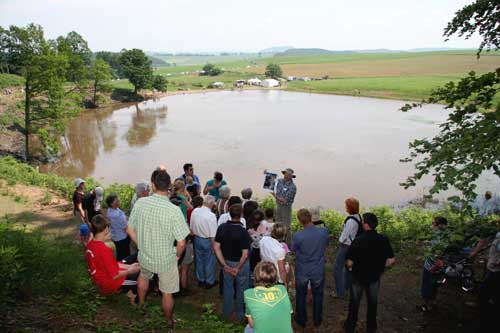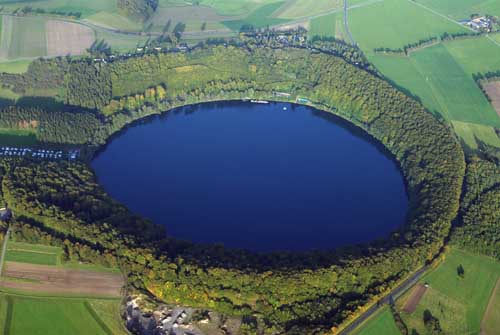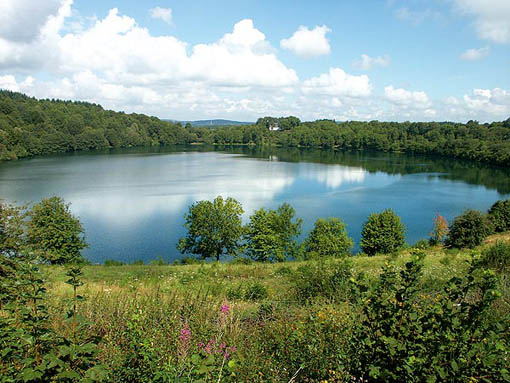
During the last five years university institutes conducted a lot of field work and geophysical investigations at a place that seem to be a maar-like structure. Now it is scientifically prooen and evident that this structure is a real maar volcano. In old maps of the 18. century this depression contained a lake which was then drained by local peasants. After 200 hundred years of agricultural use as pasture the maar lake was restored in spring 2008. This was celebrated with a maar-lake-festival. This "new" maar, Eichholz Maar, is number 75 in the list of the maars that are scientifically proven and from which now 10 contain a maar-lake.
Vulkaneifel Geopark
Locatedin the middle of Central Europe, as northwestern part of the „Rheinish Slate Mountains“ the rolling Eifel highlands show a smooth, hilly landscape with v-shaped, sometimes deep valleys cut into old Devoniansediments.Volcanoes are conspicuous, 350 eruption centres are known up to now, from which this landscape received its dominant morphological shaping and the name VULKAN EIFEL.

In some craters bogs with their specific vegetation have taking over the former lake while others are dry or only remnants remain. The maar lake sediments reveal a nearly uninterrupted stack of warvites dating back to 150.000 years ago and delivering data for the reconstruction of climate, vegetation and ecology of middle europe. Fossils found in the sediments of Eckfeld Maar, 43 million years old, have a worldwide importance, likean archetypal horse with a foetus or the oldest known honey bee. The Vulkaneifel attracts geo-scientists since 200 years and multidisciplinary, national and internationalresearch projects are permanently carried out. Geophysical data reveal that the conditions for volcanic activity are still existing under the VULKANEIFEL surface.
Moreover, the geological heritage is extremely diverse . Beside the volcanic features the Vulkaneifel discloses the geological history of the last 400 million years, beginning with a large stack of Lower-Devonian clastic sediments overlain by the famous calcareous Middle-Devonian reefs.

The Vulkaneifel is synonymous for theWest Eifel Volcanic Field, which is best known for its maar volcanism. Nearly exclusively primitive ultrabasic magma (SiO2contents less than 45 %) reached the surface and formed monogenetic volcanoes. A number of these volcanoes are known for cumulate nodules derived from the upper mantle. The younger volcanic phase of activity may have started about 1 Million years ago as dated by K/Ar. Since the youngest of the 270 quaternary volcanic vents is only 10.000 years old it can be assumed that the the probability is high that the volcanic activitywill continue in the near geological future.
The Vulkaneifel represents the classical maar area of the world.Up to know, 74 maars are revealed by scientific research. Nine maar craters are still filled with water and contain a maar-lake;others contain bogs, are dry or eroded to their remnants. These dry-maars not at all have less importance.